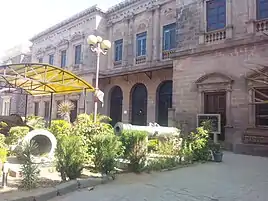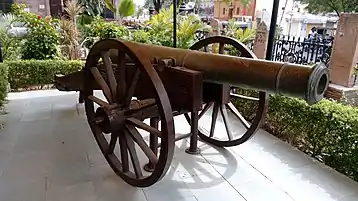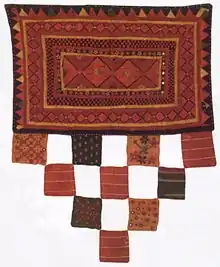Kutch Museum
Kutch Museum in Bhuj is the oldest museum of Gujarat. It is located opposite Hamirsar Lake in Bhuj, Kutch, Gujarat, India. The museum was earlier known as Fergusson Museum.[1][2]
 Museum building gate | |

| |
| Established | 1 July 1877 |
|---|---|
| Location | Opposite Hamirsar Lake, Bhuj, Gujarat, India |
| Coordinates | 23°14′55″N 69°39′59″E |
| Type | Local museum, History museum, Art Museum |
| Founder | Khengarji III |
History
Kutch museum was initially formed as a part of the School of Arts established by Khengarji III, the Maharao of Cutch State. It was founded on 1 July 1877.[3][1][4][5][2] At the time of Maharao Khengarji III's marriage on 19 February 1884 many new items were received and for exhibition of which, a need for new building was necessitated. As such, on 14 November 1884, the foundation stone for the present museum building was laid by the Governor of Bombay, Sir James Fergusson and named Fergusson Museum after him by Maharao of Cutch. The building consisting of two floors cost Rs. 32000 at that time. The museum, constructed in the Italian Gothic style, is located in the picturesque surroundings on the bank of Hamirsar Lake just opposite to the Nazar Bagh Garden.[3] It was designed by the state engineer - Mc Lelland[5] and built by local builders known as Mistris of Kutch under supervision of State Gaidher - Jairam Ruda Gajdhar.[6][7] The museum remained the preserve of the Maharao of Cutch, till 1948, who showed it only to his personal guests. In those days museum was opened to the public only on important religious occasions.[3][5]
Collections
The museum has the largest existing collection of Kshatrapa inscriptions, dating to the 1st century AD. The oldest Kshatrap six inscription-stones found in Andhau village in Khavda are moved here. They are originally on the hillock and called Lashti. They were erected in time of Rudradaman I.[8] The only Gujarati Abhir inscription of the 3rd century is also here. It also has examples of the extinct Kutchi script (now the Kutchi language is mostly written in the Gujarati script) and an interesting collection of coins, including the Koris - Kutch's local currency till 1948.[3][4][5]
This museum has almost 11 sections. The archeological section has Indus seals. Different kinds of stone tablets are available also. The painting showing the different vocations of Kutch are on the display. There is also an excellent section which covers classical and musical instruments like Nagfani, Morchang and many others, which are put on the display of the museum.
A section of the museum is devoted to tribal cultures, with many examples of ancient artifacts, folk arts and crafts and information about tribal peoples. The museum also has exhibits of embroidery, paintings, arms, musical instruments, sculpture and precious metalwork.[4]
Thus the museum broadly contains, a picture gallery, an anthropological section, an archeological section, textiles, weapons, musical instruments, a shipping section, and even stuffed animals.[1]
On the ground floor of the museum, in the center room, ‘Airavat’ is displayed. ‘Airavat’ is a carved, wooden, snow white Indian elephant with seven tusks. ‘Airavat’ was prepared in Mandvi in the 18th century, in the worship of Tirthankar. The rest of its body is painted with flowers. The Indian Government issued a postal stamp in 1978, depicting this ‘Airavat’, under the postal series "Treasures of Museum".[3][5][9]
The oldest museum of Gujarat, Kutch Museum was also first museum of India to become online virtual museum in 2010.[10]
Gallery
 Kutch Museum
Kutch Museum Cannon Haidari, a cannon gifted by Tipu Sultan to Kutch administrator Fateh Muhammad. He wanted Kutch Horses in exchange.
Cannon Haidari, a cannon gifted by Tipu Sultan to Kutch administrator Fateh Muhammad. He wanted Kutch Horses in exchange. Embroidered hanging, Kutch Museum
Embroidered hanging, Kutch Museum Tea and coffee service, Kutch, Gujarat, India, c. 1880 - Royal Ontario Museum
Tea and coffee service, Kutch, Gujarat, India, c. 1880 - Royal Ontario Museum
References
- Kutch Museum
- Kutch Museum
- Kutch Museum
- Kutch Museum Archived 25 September 2013 at the Wayback Machine
- Kutch Museum, Bhuj
- Kutch Gurjar Kshatriyas : A brief History & Glory : by Raja Pawan Jethwa, Calcutta, 2007 Page:63 Jairam Ruda Gajdhar of Mistri community was the Gaidher of the State during reign of Pragmulji II and part of reign Khengwarji Bawa, when Prag Mahal, Alfred High School, Fergusson Museum, embankment of Hamirsar Lake, etc. were constructed.
- Nanji Bapa ni Nondhpothi Author : Nanji Gavindji Taunk compiled by Dharsi J. Taunk, Jamshedpur, Published at Vadodara : pp:03
- Hasmukh Dhirajlal Sankalia (1941). The Archaeology of Gujarat: Including Kathiawar. Natwarlal & Company. p. 46. Alt URL
- A 25 paisa stamp was issued on 27 July 1978 under the `Treasures of Museum' series on Kutch Museum. Jainism in Philataly
- Kutch museum's virtual reality